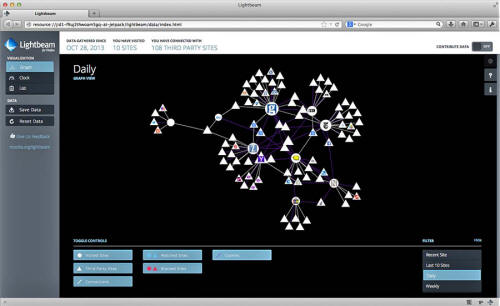 '
'
by Brian Fung
October 3, 2013
from
WashintongPost Website
|
Brian Fung covers technology
for The Washington Post, focusing on electronic privacy, national
security, digital politics and the Internet that binds it all
together. He was previously the technology correspondent for
National Journal and an associate editor at the Atlantic. His
writing has also appeared in Foreign Policy, Talking Points Memo,
the American Prospect and Nonprofit Quarterly. |

When your browser landed on this article, it didn't just talk to the
friendly servers at washingtonpost.com.
It also made contact with Chartbeat, a company
that helps us understand where else you've been on the Web, and how you're
interacting with the site. Your browser also connected to a personalized
news applet called Trove, various marketing plug-ins and a social
bookmarking service run by a company known as AddThis.
The same is true of the vast majority of sites you'll visit today.
Third-party trackers are watching practically everything you do online. Some
are innocuous in that they help enhance your Web experience. Others are
really annoying - things that you, as a consumer, probably wouldn't want
looking over your shoulder.
To help you see which sites are sending your information to third parties,
the folks at Mozilla have designed a way to visualize these trackers. It's
called
Lightbeam. (Unfortunately, the tool works
only on Mozilla's Firefox browser).
When you launch it, it shows up blank - an empty
canvas waiting for your browsing history to turn it into a detailed online
portrait of you.

From there, it quickly becomes something of a digital Jackson Pollock. Sites
you visit appear as a white circle. Associated plug-ins branch out from that
circle as white triangles.
Here's what happens when you visit Nordstrom.com,
for instance:

And here's what it looks like when you've visited more than a few sites:

In just the 10 sites that I visited over the course of that session you see
above, my browser made contact with over 100 third-party sites, some of
which had relationships with each other and were likely passing my data back
and forth.
It's an engrossing visualization of a part of the Internet people rarely
see.
There's a whole ecosystem of trackers that
latches on to you in the same way that wood-smoke or the smell of food can
give away where you've been in the physical world recently.
"This is like the Wizard of Oz," says Alex
Fowler, who leads privacy and public policy for Mozilla. "We're pulling
back the curtain here, and this is how the machinery works. This is what
the inner workings of the Web really look like."
So what can consumers do with this information?
Mozilla hopes they'll become more conscious of
the Web's underlying connective tissue. Beyond that, the company doesn't get
much into
specifics.
But Mozilla has also been active in promoting
Firefox's
Do Not Track function, which indicates
to Web sites when a user doesn't want to be tracked. Presumably Lightbeam
and DNT are meant to be complementary:
Once users realize the extent to which
they're being followed, they'll either switch on DNT (which doesn't, by
itself, end the tracking; only the retailer can make that call) or
better yet, become an advocate for a
national Do-Not-Track policy, whose
prospects have been flagging of late.
The likelihood that Mozilla could convert an
average consumer into an effective lobbyist this way - and wind up
succeeding in what's still an obscure policy fight - seems remote.
Still, the organization has a great deal to gain
from describing, in easily understood visual terms, a previously abstruse
and impenetrable side of the Internet.




